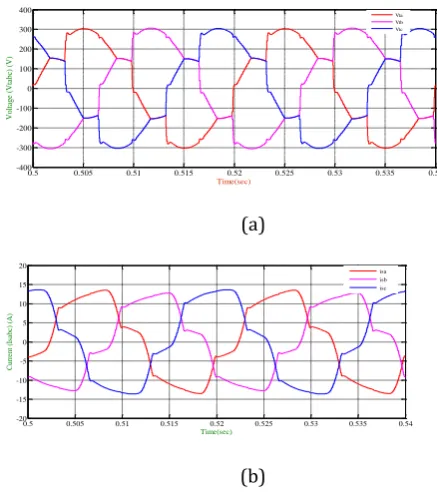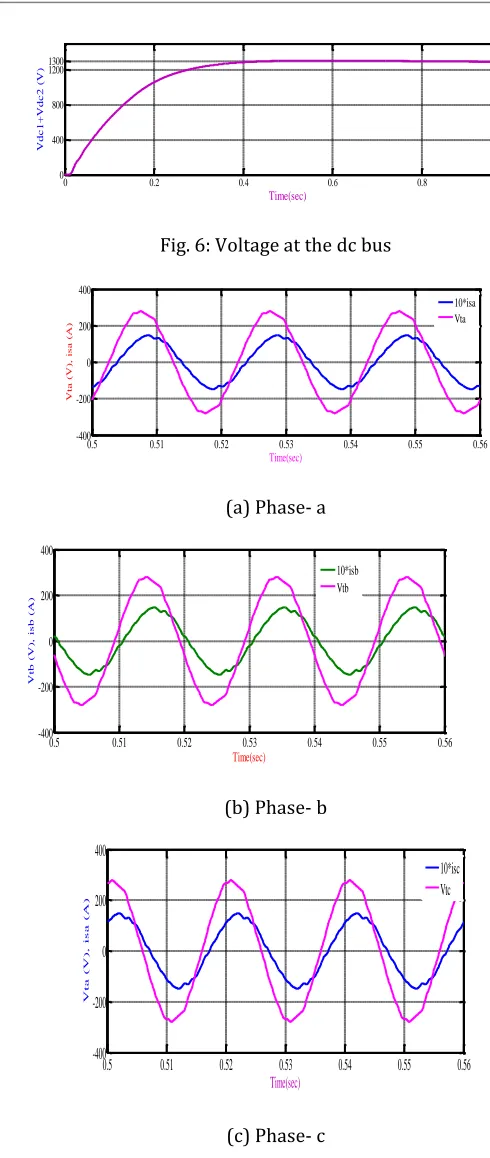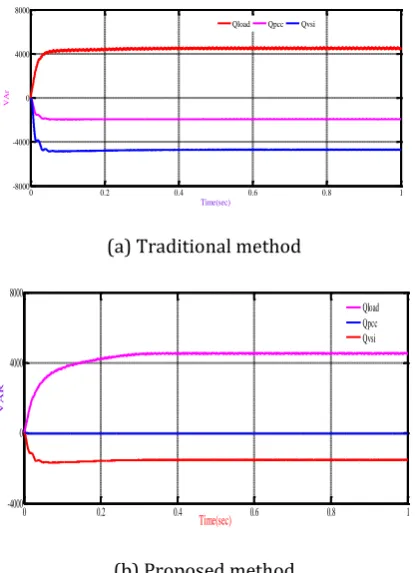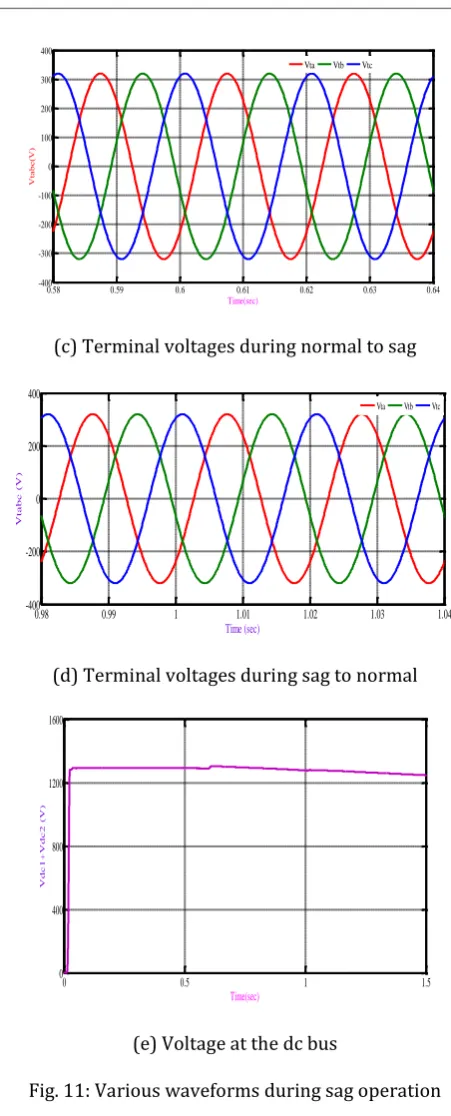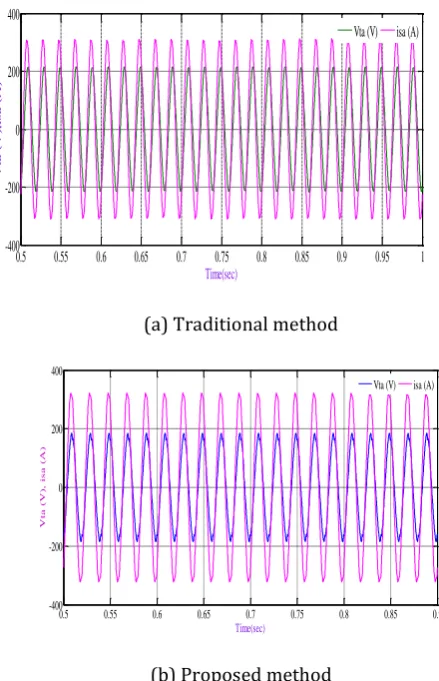© 2016, IRJET | Impact Factor value: 4.45 | ISO 9001:2008 Certified Journal
| Page 1263
POWER QUALITY IMPROVEMENT USING DISTRIBUTION STATIC
COMPENSATOR OPERATING IN VOLTAGE CONTROL MODE
K. SWETHA
(PG Scholor, Dept of EEE (EPS), SKD, Gooty, Andhrapradesh, India.)
K.SWATHI
(Assistant Professor, Dept of EEE, SKD, Gooty, Andhrapradesh, India).
N.NARASIMHULU
(Associate Professor & HOD, Dept of EEE, SKD, Gooty, Andhrapradesh, India)
Dr.R.RAMACHANDRA
(Principal SKD, Gooty, Andhrapradesh, India)
---***---Abstract:-In this project, a new algorithm to generate reference voltage for a distribution static compensator (dstatcom) operating in voltage-control mode. The proposed scheme exhibits several advantages compared to traditional voltage-controlled dstatcom where the reference voltage is arbitrarily taken as 1.0 p.u. The proposed scheme ensures that unity power factor (upf) is achieved at the load terminal during nominal operation, which is not possible in the traditional method. Also, the compensator injects lower currents and, therefore, reduces losses in the feeder and voltage-source inverter. Further, a saving in the rating of dstatcom is achieved which increases its capacity to mitigate voltage sag. Nearly upf is maintained, while regulating voltage at the load terminal, during load change. The state-space model of dstatcom is incorporated with the deadbeat predictive controller for fast load voltage regulation during voltage disturbances.
With these features, this scheme allows dstatcom to tackle power-quality issues by providing power factor correction, harmonic elimination, load balancing, and voltage regulation based on the load requirement.
INTRODUCTION
Power quality is becoming important due to proliferation of nonlinear loads, such as rectifier equipment, adjustable speed drives, domestic appliances and arc furnaces. These nonlinear loads draw non-sinusoidal currents from ac mains and cause a type of current and voltage distortion called as ‘harmonics’. These harmonics causes various problems in power systems and in consumer products such as equipment overheating, capacitor blowing,
motor vibration, transformer over heating excessive neutral currents and low power factor.
Power quality problems are common in most of commercial, industrial and utility networks. Natural phenomena, such as lightning are the most frequent cause of power quality problems. Switching phenomena result in oscillatory transients in the electrical supply.
For all these reasons, from the consumer point of view, power quality issues will become an increasingly important factor to consider in order satisfying good productivity. To address the needs of energy consumers trying to improve productivity through the reduction of power quality related process stoppages and energy suppliers trying to maximize operating profits while keeping customers satisfied with supply quality, innovative technology provides the key to cost-effective power quality enhancements solutions. However, with the various power quality solutions available, the obvious question for a consumer or utility facing a particular power quality problem is which equipment provides the better solution.
© 2016, IRJET | Impact Factor value: 4.45 | ISO 9001:2008 Certified Journal
| Page 1264
Hence power quality is ultimately a consumer-driven issue, and the end user’s point of reference the power quality is defined as “Any power problem manifested in voltage, current or frequency deviations that results in failure or misoperation of customer equipment”.
The Power system network is designed to operate at a sinusoidal voltage of a given frequency (typically 50 or 60Hz) and magnitude. Any recordable variation in the waveform magnitude, frequency, or purity is a potential power quality problem. In practical power system, there is always a close relationship between voltage and current. Even if the generators supply a pure sine-wave voltage, the current passing through the impedance of the system can cause a variety of disturbances to the voltage. For example,
Therefore, while it is the voltage with which we are ultimately concerned, we must also address phenomena in the current to understand the basis of many power quality problems.
LITERATURE SURVEY
A distribution system suffers from current as well as voltage-related power-quality (PQ) problems, which include poor power factor, distorted source current, and voltage disturbances. A DSTATCOM, connected at the point of common coupling (PCC), has been utilized to mitigate both types of PQ problems . When operating in current control mode (CCM), it injects reactive and harmonic components of load currents to make source currents balanced, sinusoidal, and in phase with the PCC voltages. In voltage-control mode (VCM), the DSTATCOM regulates PCC voltage at a reference value to protect critical loads from voltage disturbances, such as sag, swell, and unbalances. However, the advantages of CCM and VCM cannot be achieved simultaneously with one active filter device, since two modes are independent of each other.
Hence, it is not necessary to regulate the PCC voltage at 1.0 p.u. While maintaining 1.0-p.u. voltage, DSTATCOM compensates for the voltage drop in feeder. For this, the compensator has to supply additional reactive currents which increase the source currents. This increases losses in the voltage-source inverter (VSI) and feeder. Another important aspect is the rating of the VSI. Due to increased current injection, the VSI is de-rated in steady-state condition. Consequently, its capability to mitigate deep voltage sag decreases. Also, UPF cannot be achieved when the PCC voltage is 1 p.u. In the literature, so far, the operation of DSTATCOM is not reported where the
advantages of both modes are achieved based on load requirements while overcoming their demerits.
EXISTING SYSTEM
This thesis considers the operation of DSTATCOM in VCM and proposes a control algorithm to obtain the reference load terminal voltage. This algorithm provides the combined advantages of CCM and VCM. The UPF operation at the PCC is achieved at nominal load, whereas fast voltage regulation is provided during voltage disturbances. Also, the reactive and harmonic component of load current is supplied by the compensator at any time of operation. The deadbeat predictive controller is used to generate switching pulses. The control strategy is tested with a three-phase four-wire distribution system. The effectiveness of the proposed algorithm is validated through detailed simulation results
PROPOSED SYSTEM
Fig.1: Circuit diagram of the DSTATCOM-compensated distribution system
Fig.2: Single-phase equivalent circuit of DSTATCOM
© 2016, IRJET | Impact Factor value: 4.45 | ISO 9001:2008 Certified Journal
| Page 1265
Circuit diagram of a DSTATCOM-compensated distribution system is shown in Fig. 1. It uses a three-phase, four-wire, two-level, neutral-point-clamped VSI. This structure allows independent control to each leg of the VSI Fig. 5.2 shows the single-phase equivalent representation of Fig. 5.1. Variable ‘u’ is a switching function, and can be either +1 or -1 depending upon switching state. Filter inductance and resistance are Lfand Rf, respectively. Shunt capacitor Cfc
[image:3.595.57.264.231.385.2]eliminates high-switching frequency components.
[image:3.595.307.526.355.602.2]Fig.3: Overall block diagram of the controller to control DSTATCOM in a distribution system
Table 1: Simulation Parameters
S. No.
System quantities Values
1. Source Voltage 400 V rms line-line, 50Hz
2. Feeder impedance Zs= 1+j3.14Ω
3. Linear load Zla = 30+j62.8Ω
Zlb = 40+j78.5Ω
Zlc = 50+j50.24Ω
4. Non-linear load An R-L load of 50+j62.8Ω
5. VSI Parameters Vdc = 650 V, Cdc = 2600 µF, Rf =1Ω,
Lf =22Mh
Cfc =5µF, Irated = 30A
6. PI gains ,
7. Hysteresis Band (h) 1V
First, discrete modeling of the system is presented to obtain a discrete voltage control law, and it is shown that the PCC voltage can be regulated to the desired value with
properly chosen parameters of the VSI. Then, a procedure to design VSI parameters is presented. A proportional-integral (PI) controller is used to regulate the dc capacitor voltage at a reference value. Based on instantaneous symmetrical component theory and complex Fourier transform, a reference voltage magnitude generation scheme is proposed that provides the advantages of CCM at nominal load. The overall controller block diagram is shown in Fig.3.
SIMULATION RESULT ANALYSIS
Terminal voltages and source currents before compensation are plotted in Fig. 4. Distorted and unbalanced source currents flowing through the feeder make terminal voltages unbalanced and distorted. Three conditions, namely, nominal operation, operation during sag, and operation during load change are compared between the traditional and proposed method. In the traditionalmethod, the reference voltage is 1.0 p.u.
0.5 0.505 0.51 0.515 0.52 0.525 0.53 0.535 0.54
-400 -300 -200 -100 0 100 200 300 400
Time(sec)
V
ol
ta
ge
(
V
ta
bc
)
(V
)
Vta Vtb Vtc
(a)
0.5 0.505 0.51 0.515 0.52 0.525 0.53 0.535 0.54
-20 -15 -10 -5 0 5 10 15 20
Time(sec)
C
ur
re
nt
(
Is
abc
)
(A
)
isa isb isc
(b)
Fig. 4: Before compensation. (a) Terminal voltages. (b) Source currents
Nominal Operation
[image:3.595.30.292.454.738.2]© 2016, IRJET | Impact Factor value: 4.45 | ISO 9001:2008 Certified Journal
| Page 1266
supplying load reactive and harmonic currents. Fig. 6(a) shows the dc bus voltage regulated at a nominal voltage of 1300 V. Fig. 6(b) shows the load angle settled around 8.50.
Using the proposed method, terminal voltages and source currents in phases, and are shown in Fig.7 (a)–(c), respectively. It can be seen that the respective terminal voltages and source currents are in phase with each other, in addition to being balanced and sinusoidal. Therefore, UPF is achieved at the load terminal.
0.5 0.51 0.52 0.53 0.54 0.55 0.56
-400 -200 0 200 400 Time(sec) V t a ( V ) , i s a ( A ) 10*isa Vta
(a) Phase- a
0.5 0.51 0.52 0.53 0.54 0.55 0.56
-400 -200 0 200 400 Time(sec) V t b ( V ) , i s a ( A ) 10*isb Vtb (b) Phase-b
0.5 0.51 0.52 0.53 0.54 0.55 0.56
-400 -200 0 200 400 Time(sec) V t c ( V ) , i s a ( A ) 10*isc Vtc (c) Phase-c
Fig. 5: Terminal voltages and source currents using the traditional method
0 0.2 0.4 0.6 0.8 1
[image:4.595.296.541.82.661.2]0 400 800 1200 1300 Time(sec) V dc 1+ V dc 2 (V )
Fig. 6: Voltage at the dc bus
0.5 0.51 0.52 0.53 0.54 0.55 0.56
-400 -200 0 200 400 Time(sec) V ta ( V ) , is a ( A ) 10*isa Vta
(a) Phase- a
0.5 0.51 0.52 0.53 0.54 0.55 0.56
-400 -200 0 200 400 Time(sec) V tb ( V ) , is b ( A ) 10*isb Vtb
(b) Phase- b
0.5 0.51 0.52 0.53 0.54 0.55 0.56
-400 -200 0 200 400 Time(sec) V t a ( V ) , i s a ( A ) 10*isc Vtc
[image:4.595.63.307.225.684.2](c) Phase- c
Fig. 7: Terminal voltages and source currents using the proposed method.
For the considered system, waveforms of load reactive power (Qload), compensator reactive power (QVSI),
and reactive power at the PCC (QPCC) in the traditional and
© 2016, IRJET | Impact Factor value: 4.45 | ISO 9001:2008 Certified Journal
| Page 1267
needs to overcome voltage drop across the feeder by supplying reactive power into the source. As shown in Fig. 5.8(a), reactive power that is supplied by the compensator and has a value of 4.7kVAr is significantly more than the load reactive power demand of 2.8kVAr. This additional reactive power of 1.9kVAr goes into the source. This confirms that significant reactive current flows along the feeder in the traditional method. However, in the proposed method, UPF is achieved at the PCC by maintaining suitable voltage magnitude. Thus, the reactive power supplied by the compensator is the same as that of the load reactive power demand. Consequently, reactive power exchanged by the source at the PCC is zero. These waveforms are given in Fig. 8(b).
0 0.2 0.4 0.6 0.8 1
-8000 -4000 0 4000 8000
Time(sec)
VAr
Qload Qpcc Qvsi
(a) Traditional method
0 0.2 0.4 0.6 0.8 1
-4000 0 4000 8000
Time(sec)
VAR
Qload Qpcc Qvsi
[image:5.595.317.546.57.712.2](b) Proposed method
Fig. 8: Load reactive power (Qload), Compensator reactive
power (QVSI), and reactive power at PCC (QPCC)
Fig. 9(a) and (b) shows the source rms currents in phase for the traditional and proposed methods, respectively. The source current has decreased from 11.35 to 10.5 A in the proposed method. Consequently, it reduces the ohmic losses in the feeder. Fig. 10(a) and (b) shows the compensator rms currents in phase- for the traditional and proposed methods, respectively. The current has decreased from 8.4 to 5.2 A in the proposed method.
0.5 0.75 1
0 2 4 6 8 10 12
Time(sec)
I
s
a
(
A
)
(a) Traditional method
0.5 0.75 1
0 2 4 6 8 10 12 14
Time(sec)
I
s
a
(
A
)
[image:5.595.325.549.72.400.2](b) Proposed method
Fig. 9: Phase-a’ source rms currents
0.4 0.6 0.8 1
0 5 10
Time(sec)
I
f
i
a
(
A
)
(a) Traditional method
0 0.2 0.4 0.6 0.8 1
0 5 10
Time(sec)
I
f
ia
(
A
)
[image:5.595.59.267.321.608.2](b) Proposed method
Fig. 10: Phase-a’ compensator rms currents
[image:5.595.324.539.400.707.2]© 2016, IRJET | Impact Factor value: 4.45 | ISO 9001:2008 Certified Journal
| Page 1268
compensate for the entire feeder drop. Hence, at the steady state, the compensator supplies reactive power to the source to overcome this drop. However, in the proposed scheme, the compensator does not compensate for the feeder drop in the steady-state condition. Hence, a lesser rating of VSI is utilized in the steady state. This savings in rating is utilized to mitigate deep sag, and DSTATCOM capacity to mitigate deep sag increases.
Operation during Sag
To create sag, source voltage is lowered by 20% from its nominal value at 0.6 s as shown in Fig. 11(a). Sag is removed at 1.0 s as shown in Fig. 11(b). Since voltage regulation capability does not depend upon reference voltage, it is not shown separately for the traditional method. Fig. 11(c) and (d) shows terminal voltages regulated at their reference value.
The controller provides a fast voltage regulation at the load terminal. Fig. 11(e) shows the total dc bus voltage. During the transient period, capacitors supply real power to maintain load power which results in discharging of capacitors.
If the rating of VSI is limited to mitigate 20% sag, then this savings in rating can be used to mitigate additional sag.
0.58 0.59 0.6 0.61 0.62 0.63 0.64
-400 -200 0 200 400
Time(sec)
V
s
a
bc
(
V
)
Vsa Vsb Vsc
(a) Source voltages during normal to sag
0.98 0.99 1 1.01 1.02 1.03 1.04
-400 -200 0 200 400
Time(sec)
V
s
a
bc
(
V
)
Vsa Vsb Vsc
(b) Source voltages during sag to normal
0.58 0.59 0.6 0.61 0.62 0.63 0.64
-400 -300 -200 -100 0 100 200 300 400
Time(sec)
V
ta
bc
(V
)
Vta Vtb Vtc
(c) Terminal voltages during normal to sag
0.98 0.99 1 1.01 1.02 1.03 1.04
-400 -200 0 200 400
Time (sec)
V
ta
bc
(
V
)
Vta Vtb Vtc
(d) Terminal voltages during sag to normal
0 0.5 1 1.5
0 400 800 1200 1600
Time(sec)
V
dc
1+
V
dc
2
(
V
)
[image:6.595.316.542.79.638.2](e) Voltage at the dc bus
Fig. 11: Various waveforms during sag operation
[image:6.595.332.534.368.595.2]© 2016, IRJET | Impact Factor value: 4.45 | ISO 9001:2008 Certified Journal
| Page 1269
capability to mitigate deep sag independent of duration. However, it requires a high current rating of the VSI.
0 1 2 3 4 5
-400 -200 0 200 400
Time(sec)
V
s
a
bc
(V
)
Vsa Vsb Vsc
(a) Source voltages
0 1 2 3 4 5
-400 -200 0 200 400
Time(sec)
V
ta
bc
(
V
)
Vta Vtb Vtc
(b) Terminal voltages
0 0.5 1 1.5 2 2.5 3 3.5 4 4.5 5
0 0.5 1 1.3 1.5 2
Time(sec)
V
dc
1+
V
dc
2
(
kV)
[image:7.595.60.265.157.583.2](c) Voltage at the dc bus
Fig. 12: Voltage waveforms during sag operation in the proposed method.
Operation during Load Change
To show the impact of load changes on system performance, load is increased to 140%of its nominal value. Under this condition, the traditional method gives less power factor as the compensator will supply more reactive current to maintain the reference voltage. The voltage and current waveforms, as shown in Fig. 13(a), confirm this. In proposed method, a load change will result in small deviation in terminal voltage from its reference voltage.
Compensator just needs to supply extra reactive current to overcome this small extra feeder drop, hence, nearly UPF is maintained while regulating the terminal voltage at its reference voltage. It is evident from Fig. 13(b).
0.5 0.55 0.6 0.65 0.7 0.75 0.8 0.85 0.9 0.95 1
-400 -200 0 200 400
Time(sec)
V
t
a
(
V
)
,
i
s
a
(
A
)
Vta (V) isa (A)
(a) Traditional method
0.5 0.55 0.6 0.65 0.7 0.75 0.8 0.85 0.9
-400 -200 0 200 400
Time(sec)
V
t
a
(
V
)
,
i
s
a
(
A
)
Vta (V) isa (A)
[image:7.595.313.533.162.503.2](b) Proposed method
Fig. 13: Terminal voltage and source current in phase- during load change
CONCLUSIONS
© 2016, IRJET | Impact Factor value: 4.45 | ISO 9001:2008 Certified Journal
| Page 1270
improve several PQ problems (related to voltage and current).
FUTURESCOPE
The proposed method will also validate through any simulation software packages and it will possible to implement experimentally.
REFERENCES
[1]. M. Bollen, Understanding Power Quality Problems. Piscataway, NJ, USA: IEEE, 2000, ch. 1, pp. 1–35. [2]. Fujita and H. Akagi, “Voltage-regulation
performance of a shunt active filter intended for installation on a power distribution system,” IEEE
Trans. Power Electron., vol. 22, no. 3, pp. 1046–1053,
May 2007.
[3]. A. Ghosh and G. Ledwich, “Load compensating DSTATCOM in weak ac systems,” IEEE Trans. Power Del., vol. 18, no. 4, pp. 1302–1309, Oct. 2003. [4]. A. Elnady and M. Salama, “Unified approach for
mitigating voltage sag and voltage flicker using the DSTATCOM,” IEEE Trans. Power Del., vol. 20, no. 2, pt. 1, pp. 992–1000, Apr. 2005.
[5]. S. Rahmani, A. Hamadi, and K. Al-Haddad, “A Lyapunov-functionbased control for a three-phase shunt hybrid active filter,” IEEE Trans. Ind. Electron., vol. 59, no. 3, pp. 1418–1429, Mar. 2012.
[6]. M. K. Mishra and K. Karthikeyan, “A fast-acting dc-link voltage controller for three-phase DSTATCOM to compensate ac and dc loads,” IEEE Trans. Power Del., vol. 24, no. 4, pp. 2291–2299, Oct. 2009. [7]. M. K. Mishra, A. Ghosh, A. Joshi, and H. M.
